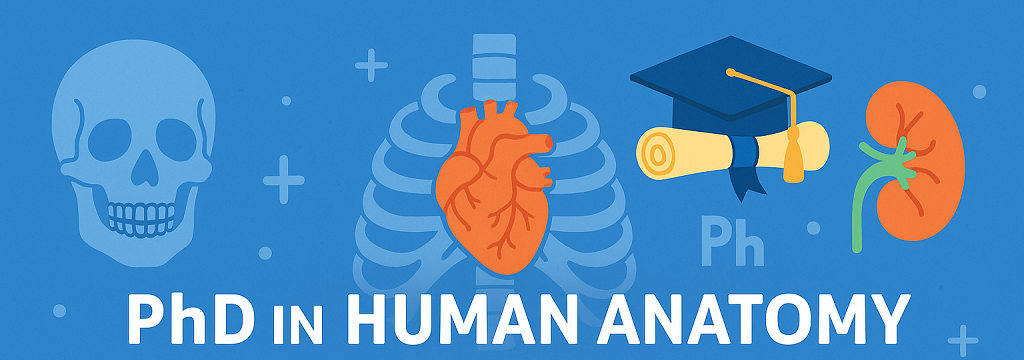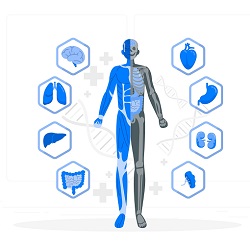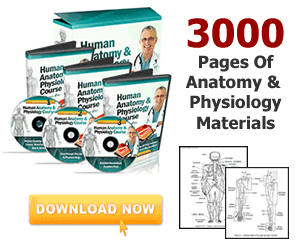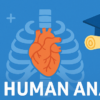
Pursuing a PhD in human anatomy is a transformative step for those captivated by the complexities of the human body. Often combined with a PhD in human physiology, this advanced degree equips students to explore the structures and functions that sustain life. As medical research and education continue to evolve, the demand for experts in these fields is steadily increasing. For aspiring scholars, a PhD in human anatomy offers an opportunity to contribute to science while building a fulfilling career. This blog explores the key aspects of earning this degree and how Dr. James Ross’s course can enhance your knowledge. Whether your goal is to teach or innovate, let’s uncover the path to success.
Why Pursue a PhD in Human Anatomy?
Advancing Medical Knowledge
A PhD in human anatomy positions you at the forefront of understanding the body’s structural framework. It is the study of the structure and form of the human body, focusing on its physical components and their relationships. Research in anatomy drives breakthroughs in surgery, prosthetics, and regenerative medicine. Scholars dissect cadavers, use 3D imaging, or model tissues to push boundaries. This degree, often paired with a PhD in human physiology, explores how structures enable function. Human physiology examines how the body’s structures function, including the processes and mechanisms that enable them to operate. A PhD in these areas is your ticket to shaping medical futures. Anatomy deals with “what” the body is, while physiology deals with “how” it works.

Diverse Career Opportunities
A main reason for advancing from a master’s to a PhD in any field is the potential for career growth and competitive salaries. Graduates with a PhD in human anatomy often thrive in academia, teaching future doctors and researchers. With a PhD, you can teach a wide range of medical and health science courses while also contributing to curriculum development. Academic salaries typically range from $90,000 to $120,000, with tenure-track positions offering long-term stability and influence. In this role, you may also supervise PhD students, blending hands-on mentorship with advanced instruction. Leading universities, such as the top 10 universities in the US or Australia’s Group of Eight, actively seek experts with this background.
Outside academia, a PhD in human anatomy or a PhD in human physiology opens doors in the biotech and pharmaceutical industries. Companies like Stryker and Medtronic hire anatomists for implant design, surgical technologies, and product development, with salaries reaching up to $150,000. Research institutes value your expertise for grant-funded, cutting-edge projects. Additionally, your skills are in demand in fields like forensics or 3D anatomical modeling for animation and virtual simulation. The combination of human anatomy and physiology boosts your expertise and value in the job market. Dr. James Ross’s course significantly strengthens your foundation in both human anatomy and physiology, perfectly complementing your PhD training.
Human Anatomy and Physiology Course by Dr. James Ross
Unlike other anatomy and physiology online courses, the program created by Dr. James Ross enhances learning and retention with a 3-component teaching system that incorporates quizzes, diagrams, and illustrations. After a quick review, it is clear this course is one of the most effective courses helping students learn a large amount of information about the human body quickly and efficiently. Dr. Ross’s course has been so effective in teaching anatomy to students that it has been featured on the Martha Stewart Show as an award-winning course. Early users of the program have stated that the Human Anatomy and Physiology Course contains virtually everything they want to learn about the body within a week in an interactive, engaging, and effective style.
“This is honestly the most impressive resource on anatomy and physiology ever. As a medical teacher, these materials are a lifesaver for me. The level of detail in the human muscular module is simply fascinating”. Said Dr. Michael King, a medical teacher from Philadelphia, PA.
Frank Howard, a rescue paramedic and user of the course, said: “I can’t say enough about how the Human Anatomy and Physiology Course has helped me obtain my EMT-Basic certification. It has made learning so much easier with the step-by-step modules and quizzes”.
The Human Anatomy and Physiology Masterclass Course Content
The Human Anatomy and Physiology Course by Dr. James Ross offers over 3,000 pages of comprehensive materials typically reserved for medical professionals. While the full course is available for instant online download, a PC CD-ROM version is also available for those who prefer a physical copy. Valued at over $1,885, this extensive resource is now being offered at a remarkably low one-time cost (under $50), making it accessible to virtually anyone eager to deepen their understanding of the human body. It is a rare opportunity to gain professional-level knowledge at a fraction of the price. To purchase the program, visit the official website here:
James Ross has made a limited number of these courses available at a discounted rate, providing those who invest in the product the best level of service. Included in the course are more than 3,000 pages of content, hundreds of diagrams and illustrations, end-of-lesson quizzes and evaluations, and more. In addition, Dr. Ross offers a bonus master class about nursing and paramedics to provide even more education about the human body and how to care for it. To order the Human Anatomy and Physiology Course by Dr. Ross, click here. Along with his home study course, he offers a 60-day money-back guarantee to ensure that customers are 100% satisfied with the product.
Basics of PhD in Human Physiology and Anatomy Programs
Choosing the Right Anatomy and Physiology Program
Selecting the right PhD program in physiology or human anatomy requires aligning your research interests with faculty expertise, preferred study format (on-campus or online), financial situation, and academic background. Aim to apply to universities where at least five faculty members are actively working in your field because this increases your chances of finding a suitable supervisor and securing research-funded support. For instance, universities like Penn State, Florida, Edinburgh, or Indiana offer on-campus and hybrid PhDs in anatomical research, equipped with advanced laboratories and resources.
Most PhD anatomy applicants seek funding, so be strategic. If your academic CV is not strong, targeting top-tier universities, where competition is fierce despite greater funding, may not be practical. Understanding how to secure fully funded PhD positions is crucial. For professionals or parents unable to relocate, some explore accredited online or hybrid PhD programs. You may also consider interdisciplinary options that integrate both human anatomy and physiology. Ultimately, the key is choosing a program that aligns with your career goals and personal circumstances.
To pursue a PhD in human anatomy or a PhD in human physiology, you typically need a bachelor’s or master’s degree in biology, anatomy, physiology, or a closely related field. Most programs require a minimum GPA of 3.0 to 3.2, strong letters of recommendation, and prior research experience. Some universities may also request GRE scores, though many have made them optional in the post-COVID era. A compelling statement of purpose (for US and Canadian universities) or a motivation letter (for European institutions) is essential to connect your academic goals with the PhD program. Demonstrating genuine passion and preparedness can make all the difference in a competitive admissions process.

Structure and Timeline of PhD in Human Anatomy and Physiology
The duration of a PhD in human anatomy or physiology typically ranges from 3 to 6 years, depending on the country. In Germany, Belgium, or Australia, programs usually take 3 to 3.5 years and focus solely on research. In contrast, PhD programs in the USA and Canada last 4 to 6 years, combining coursework with research. Early-stage coursework usually includes advanced anatomy, histology, and imaging techniques, while the later stages concentrate on the PhD dissertation. Modern programs increasingly emphasize technologies like virtual dissection and often integrate physiology topics such as cardiovascular and nervous system studies. In North America, students are generally required to formally defend a research proposal after completing their coursework before progressing to full-scale research.
Research is the heart of a PhD in human anatomy or physiology, driving you to investigate complex research questions. You will utilize a range of tools from traditional microscopes to cutting-edge, AI-driven imaging technologies, and often publish your findings in peer-reviewed scientific journals. Collaboration with peers and medical institutions plays a critical role, as this is where ideas evolve and research deepens. Your dissertation, a multi-year endeavor, reflects your original contributions to the field. Strong writing and a clear defense of your findings are essential. Throughout this journey, your PhD supervisor will mentor and guide you, ensuring your work meets rigorous academic standards.
Conclusion
A PhD in human anatomy, i.e., often enriched by complementary studies in physiology, is more than an academic accomplishment. It is a commitment to advancing health, science, and education. Whether your passion lies in teaching, research, or industry innovation, this degree opens doors to meaningful, well-compensated careers across the globe. As the demand for anatomical and physiological expertise grows, those with advanced training will play a pivotal role in shaping the future of medicine and healthcare. Courses like Dr. James Ross’s provide a solid foundation, making complex concepts accessible to learners at any stage. With the right preparation and guidance, your journey toward a PhD can begin with confidence and clarity.
Frequently Asked Questions (FAQs)
Do I need a master’s degree to apply for a PhD in human anatomy and physiology?
Not always. Some programs accept international applicants with a strong bachelor’s degree, especially in America or Canada, through direct PhD programs. However, having a master’s can improve your chances.
Can I pursue a PhD in human anatomy online?
Fully online PhDs are rare due to lab requirements, but hybrid or distance-learning options exist worldwide, especially for professionals who cannot relocate.
How does Dr. James Ross’s course help PhD applicants/students?
The course offers in-depth, professional-grade content, complete with illustrations and quizzes, enabling students to build a strong foundational knowledge base during their PhD studies. If you are a master’s student, this course can significantly boost your expertise and improve your chances of PhD admission success.




2 Comments
Baye Ashenef
2 months agoHow can i gate chances for phd in physiology ??
admin
2 months agoDear Baye, Please complete your profile on Applyindex, then visit page: https://applyindex.com/full-funding-chances/.